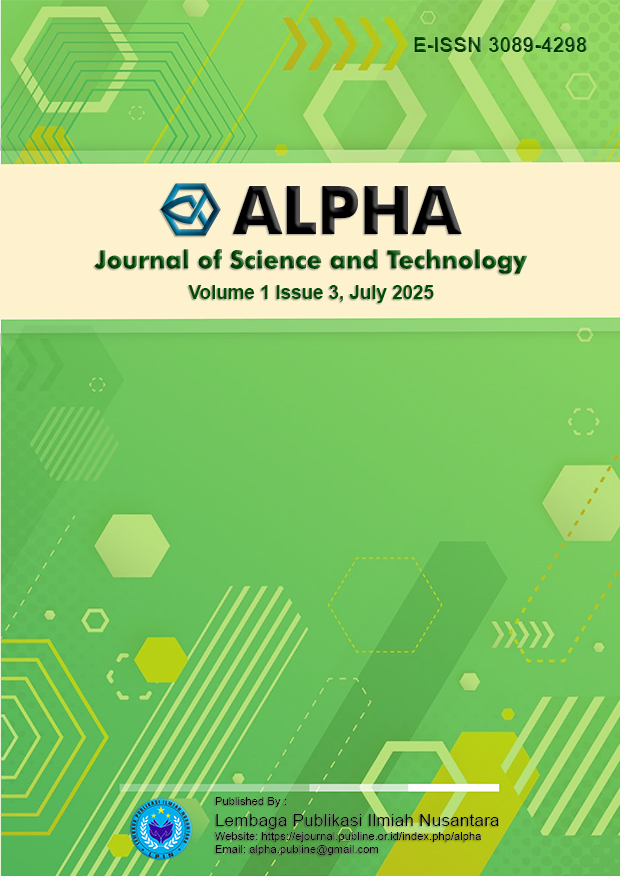Analisis Teoretis Desain Alat Pemanas Tenaga Surya dalam Menunjang Efisiensi Pengeringan Gabah
DOI:
https://doi.org/10.70716/alpha.v1i3.229Keywords:
rice drying, solar powered heater, heat transfer efficiency, theoretical analysis, heat absorber material, insulation material, airflow system, sustainable agricultural technologyAbstract
Rice drying is a pivotal post-harvest operation that directly influences grain quality, storability, and market value. Conventional sun drying methods, while widely practiced, are highly dependent on weather conditions and often result in inconsistent moisture reduction. In response to these limitations, solar-powered heating systems offer a sustainable and environmentally friendly alternative for controlled drying processes. This study presents a theoretical analysis of various solar heater design configurations and their potential impact on the efficiency of rice drying.
The research adopts a literature-based approach, synthesizing findings from previous studies on solar collector geometry, heat absorber materials, insulation techniques, and airflow mechanisms. Thermodynamic principles, including heat transfer via conduction, convection, and radiation, serve as the analytical framework to evaluate the performance of different design models. Key parameters such as collector tilt angle, surface absorptivity, glazing properties, and thermal insulation are examined for their influence on drying temperature, humidity control, and drying rate.
Findings indicate that optimal collector orientation, selective coating on absorber plates, and effective insulation significantly enhance thermal efficiency. Additionally, airflow systems—whether passive or active—play a crucial role in maintaining uniform temperature distribution and reducing relative humidity within the drying chamber. Simulated thermal models and empirical data from referenced studies suggest that solar-powered dryers can achieve moisture reduction levels that meet national standards for milled rice, with minimal energy input and reduced environmental impact.
This theoretical investigation provides a conceptual foundation for the development of solar-based rice drying technologies tailored to tropical climates. It highlights the importance of integrated design strategies that combine thermal performance, material selection, and ergonomic considerations. The study aims to support future innovations in post-harvest processing and contribute to energy-efficient agricultural practices in rural communities.
Downloads
References
Cengel, Y. A., & Boles, M. A. (2002). Thermodynamics: An Engineering Approach. McGraw-Hill Education.
Duffie, J. A., & Beckman, W. A. (2020). Solar Engineering of Thermal Processes (5th ed.). Wiley.
Heriyanto, E. Van. (2018). Rancang Bangun Pengering Gabah dengan Pengendali Suhu dan Kelembapan Berbasis Arduino Uno R3. Skripsi, STMIK STIKOM Indonesia.
Lumban Raja, F. G., Hiendro, A., & Prima, F. (2021). Rancang Bangun Pemanas Air Tenaga Surya dan Analisa Pengaruh Sudut Kemiringan Kolektor Surya terhadap Efisiensi Termal. Jurnal Teknik Mesin, Universitas Tanjungpura.
Panggabean, R., et al. (2017). Analisis Efisiensi Pengeringan Gabah Menggunakan Kolektor Surya Tipe Flat Plate. Seminar Nasional Teknik Mesin XII, hal. 355–359.
Virargo, A. (2015). Pengaruh Material Isolasi Termal terhadap Efisiensi Kolektor Surya. Jurnal Energi Terbarukan, 3(2), 45–52.
Rakasiwi, D., et al. (2018). Potensi Energi Surya di Wilayah Tropis untuk Pengeringan Gabah. Jurnal Teknologi Pertanian Tropis, 6(1), 12–20.
Numberi, J. (2022). Perbandingan Efisiensi Alat Pengering Gabah dengan Sistem Cerobong dan Kipas. Jurnal Rekayasa Energi, 4(1), 33–40.
Aryadinata, R. (2017). Desain Kolektor Surya dengan Sistem Aliran Udara Aktif untuk Pengeringan Gabah. Jurnal Teknik Energi, 5(3), 21–28.
Gultom, S. (2020). Pemanfaatan Material PCM untuk Penyimpanan Panas pada Sistem Pengeringan Gabah. Jurnal Teknologi Energi, 8(2), 55–63.
Hanafi, I., & Hariyanto, K. (2022). Perancangan Alat Pemanas Air Tenaga Surya dengan Metode Kansei Engineering. Jurnal Sistem Teknik dan Inovasi, 1(1), 19–24.
SNI 3021:1992. Pemanas Air Tenaga Surya Tipe Domestik Sistem Termosifon Langsung dengan Pemanas Tambahan. Badan Standardisasi Nasional, Jakarta.
Tangkemanda, A., et al. (2017). Optimasi Penyerapan Radiasi Kolektor Surya dengan Variasi Material dan Sudut Kemiringan. Jurnal Energi Alternatif, 2(1), 14–22.
Setyadi, F. (2018). Pengaruh Reflektor Tambahan terhadap Efisiensi Kolektor Surya. Jurnal Teknik Mesin, Universitas Negeri Semarang.
Mulyadi, A., et al. (2022). Pemanfaatan Biomassa sebagai Sumber Panas Alternatif dalam Pengeringan Gabah. Jurnal Agroindustri Berkelanjutan, 3(2), 67–74.
Downloads
Published
How to Cite
Issue
Section
License
Copyright (c) 2025 Abiel Mulya Cipta

This work is licensed under a Creative Commons Attribution-ShareAlike 4.0 International License.











